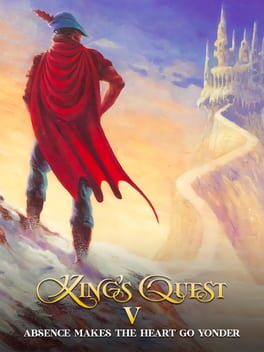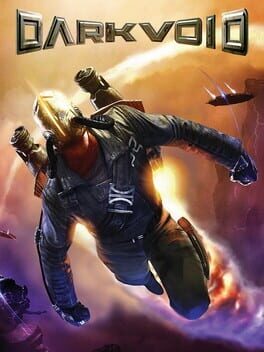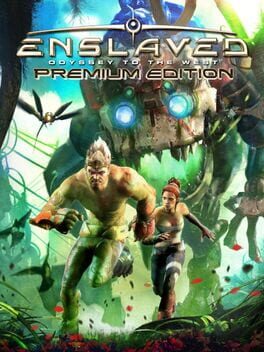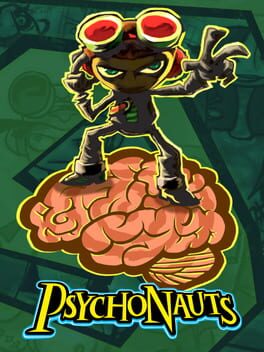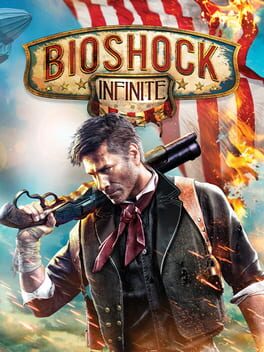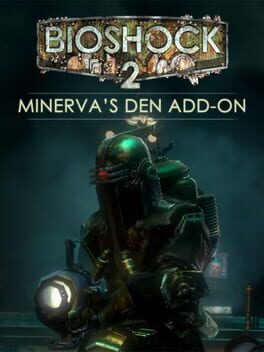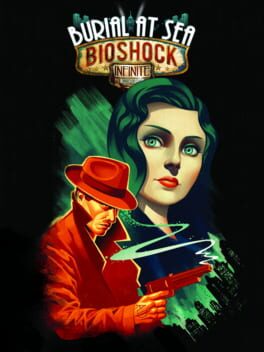oldmansyndrome
9 reviews liked by oldmansyndrome
Alan Wake II
2023
A masterclass in how to blend mediums with live action video, music created specifically to tie into the story experience, and the game itself all coming together to make an experience that blew me away from start to finish. If I have any complaints it tends to be with the gunplay and wandering which in the moment I found engaging and fun but on reflection was occasionally tedious on the hardest difficulty I opted into when I ran through the game. Also if Poe's "This Road" doesn't end up on streaming sometime soon, I'm going to lose it. Just an incredible product and something that speaks to the strength of video games as an artistic medium.
This review contains spoilers
To open this up I think point and click games in the vein of these Sierra titles are not really my thing. I also beat the game using a guide which might delegitimize my completion in someone's eyes so I figured I should disclose that too. I can appreciate the leaps and technical spectacle of this game from its predecessors which mostly relied on a text box entry style control scheme. The voice acting, audio quality (on the CD version), and color variety afforded by the generational shifts of 1990 tech allow for an interesting look into how far things have come for me. I can appreciate the game as a product of that time but I think where I find myself constantly stuck with this game is in the puzzle design and its ability (or lack thereof) to guide the player towards a solution. Often the game feels like it relies heavily on puzzle design that is unintuitive and unclear to hinder progress. I think the most egregious example of this is a "puzzle" involving throwing a boot found in the middle of the desert at a cat attacking a rat outside of a bakery. This event occurs a single time and if you fail, you have soft locked your game, something you could go hours without figuring out because even if you saved the rat its main use is to free you from a scene that previously caused an instant game over. I don't know how I was supposed to process this kind of galaxy brain puzzle design in a timely manner and maybe that is the point. Often I found myself wondering if the puzzles and potential soft lock points of the game are sprinkled throughout to engage the player for longer sessions thereby lengthening the game with each mistake. Maybe I just lack the attention span or patience to enjoy this kind of thing. The comedy and experience were elevated highly whenever I was showing the game off to friends or describing events like they were a fever dream because often the steps to solve puzzles felt like I was drafting up a corkboard in a massive conspiracy where the coin I picked up in hour one buys a pie from hour two which I throw in a yeti's face in hour 7. If I ate that pie when I was prompted by the game to eat in a frozen wasteland I would have simply never been able to defeat that dastardly yeti. I think I am less sane for having played this game. I also really like the idea mentioned in another review where you have a friend spoonfeed you hints with a guide on the side, I think if I had done that this game might have been fire.
Dark Void
2010
This review contains spoilers
Recently delisted, Dark Void may be a hidden gem to some in an industry that increasingly loses access to its history like the games industry. Personally, I feel like this game reflects a lot of the ugliest trends in the industry circa 2010. Does this mean it should have been delisted or does not deserve to be played? Absolutely not, in fact its a huge shame that games like this may be increasingly inaccessible in the future. With that preamble out of the way, lets talk about the game.
Dark Void is truly an enigma of a game. I will try to give an extremely butchered plot synopsis here for the curious. It opens with a shot of a brown skyline where a character flies via jetpack while fighting some sort of alien UFOs. The date, 1939. We watch our jetpacked player character fly acrobatically until he crash lands and is killed by some kind of scorpion robot. Cut to earth where we see someone who I assume is the same player character meeting lead characters Will and Ava. These three load up a plane and fly out to somewhere (I saw this a week ago and somehow these plot points escape me). Long story short, Will and crew crash land in the Bermuda Triangle and find themselves stranded on a jungle island. The unnamed player character from the intro is presumably killed offscreen or something because he straight up disappears as we step into the shoes of Will and begin our adventure for real. Will and Ava reunite and navigate this mysterious forest filled with some kind of blue robot guys later called the Watchers. We engage in terrible knockoff Gears of War cover shooting with these robots until Will and Ava stumble into some kind of Aztec civilization that seems to worship these robots. They tell our protagonist to shove off but Will and Ava are swiftly pulled into a lab by my boy Tavi. Turns out Nikolai Tesla, the real person is living in this Aztec temple developing some means to either leave or based on future events enter the mysterious area known as "The Void" (how spooky). Will and Ava scavenge for airplane parts to go home but after a series of events that I can't or maybe don't care to recall Ava is kidnapped by the Watchers after some sort of argument with Will about how he didn't do enough to stop World War 2 or something like that? I'm not sure, the game treats its historical setting with an insane lack of care or seriousness as the conflict and participants of World War 2 are erased from the story. Instead, Will and Ava talk vaguely about "the fascists" and how they are causing all kinds of ruckus in Europe. I chalk it up to narrative cowardice but dear reader I leave you to decide why the writers of this game decided that their game should be set in World War 2 while also taking nothing from that setting beyond vague references to fascism.
Continuing on, Will gains a jetpack and the bulk of the game begins its core loop between cover shooting and flight combat reminiscent of any plane or jet combat game ever but this time with jetpack and the worst hijacking mechanic of all time with animations that last upwards of 35 seconds to perform. You also do a ton of escorting and defending people or objects in this game which is just bottom of the barrel content in most games not named Resident Evil 4.
After the jetpack is given to the player to test out Will follows the now kidnapped Ava into "The Void." Will and the player move from the dark green and grey forests of the early 2010s to a truly terrifying setting, orange and brown rocks floating over an abyss. I can not overstate how incredibly boring the scenery is in this game. Its incredibly bland and even saying that here I know somewhere in the future I'll kick myself for not emphasizing just how bland this setting was even further.
Will meets Atem and links up with the Survivors. This is a group of refugees in "The Void" looking to...escape? I'm actually not super sure tbh, anything to do with the survivors is just incredibly confusing and not at all told to the player through the cutscenes that all just feel like they exist because that's what video games have. They all felt pointless and very few of them explained what the hell was going on in the game.
After lots of meandering and nothing going on kind of like this review, Will and Ava reunite alongside third wheel Nikolai Tesla who apparently has been helping build a big ship called the Ark. I despise the Ark because every mission involving it was a tedious escort that either felt incredibly buggy or incredibly broken on hardcore. I completed one defense mission for the Ark moments away from its destruction because Will was tasked to single-handedly fight 3 mech scorpions that somehow simultaneously shred Will into pieces and shred the Ark. The Watchers' technology is truly frightening.
At some point, Will is told that he is an Adept by Atem who I think I mentioned once before which probably says something about how memorable the cast is in this game. An Adept is basically someone who fights real good and I guess can jump like 6 feet into the air because apparently they're supposed to have special powers but I never got the sense anything Will did was because of powers considering the overwhelming reliance on a super jetpack designed by Nikolai Tesla (I think I forgot to mention he made that) and guns scavenged from robot aliens. Even Atem, one of our other known Adepts in the game is shown to just sort of shoot a robot real good and do some sort of CQC thing as his big feat to show how special he is.
It all starts to blend together here but eventually Will and the crew of the Ark are taken to some kind of prison labor camp in a scene very reminiscent of that moment in Half Life 2 where Gordon enters a pod in the Citadel and you get to see it from the inside except in that game there were things to look at that didn't make my eyes glaze over with all the grey and blue alien architecture. Will is swiftly saved by Atem who apparently planned to get caught to begin the revolution or something? Its also revealed that this prison camp (which probably gives it too much credit tbh) and the Watchers as a whole are supporting "the fascists" on earth with the war effort. So in this alien facility where every enemy shoots lasers and stuff I guess they're also building like Nazi planes and stuff? I feel like making this game connect to World War 2 was incredibly contrived, hilarious in hindsight, but contrived. Will and crew break out and then he fights a big robot dragon for some reason. After the dragon fight where Will sacrifices his super jetpack to kill it, Ava embraces him only for the true villain some alien disguised as Tavi (or maybe it was Tavi the whole time?) throws a knife at Ava stabbing her in the back in one of the most awkwardly shot cutscenes I've ever seen. Seriously, go watch this thing if you can its incredible.
To conclude this nightmare, I do think Dark Void deserves some praise for being a pretty ambitious game that transitions seamlessly between flight combat and third person shooter gameplay that was pretty standard at the time. It feels like an amalgamation of industry trends at the time though which really hinders my ability to mark it as something truly special. From casting Nolan North as our leading man to evoke the charm of Nathan Drake in a character with so little charisma to shoehorning a strange plotline about World War 2 into a game that totally would have been fine without it this game just does not feel like it forms a coherent identity of its own. It truly needed to strike out its own lane in my view if Capcom or Airtight wanted this title to be a hit. Unfortunately that didn't take and we live in the reality where this game will likely be forgotten and ignored because its no longer a stocked product on digital storefronts and finding physical media from the 360/PS3 generation is an increasingly difficult task.
Dark Void is truly an enigma of a game. I will try to give an extremely butchered plot synopsis here for the curious. It opens with a shot of a brown skyline where a character flies via jetpack while fighting some sort of alien UFOs. The date, 1939. We watch our jetpacked player character fly acrobatically until he crash lands and is killed by some kind of scorpion robot. Cut to earth where we see someone who I assume is the same player character meeting lead characters Will and Ava. These three load up a plane and fly out to somewhere (I saw this a week ago and somehow these plot points escape me). Long story short, Will and crew crash land in the Bermuda Triangle and find themselves stranded on a jungle island. The unnamed player character from the intro is presumably killed offscreen or something because he straight up disappears as we step into the shoes of Will and begin our adventure for real. Will and Ava reunite and navigate this mysterious forest filled with some kind of blue robot guys later called the Watchers. We engage in terrible knockoff Gears of War cover shooting with these robots until Will and Ava stumble into some kind of Aztec civilization that seems to worship these robots. They tell our protagonist to shove off but Will and Ava are swiftly pulled into a lab by my boy Tavi. Turns out Nikolai Tesla, the real person is living in this Aztec temple developing some means to either leave or based on future events enter the mysterious area known as "The Void" (how spooky). Will and Ava scavenge for airplane parts to go home but after a series of events that I can't or maybe don't care to recall Ava is kidnapped by the Watchers after some sort of argument with Will about how he didn't do enough to stop World War 2 or something like that? I'm not sure, the game treats its historical setting with an insane lack of care or seriousness as the conflict and participants of World War 2 are erased from the story. Instead, Will and Ava talk vaguely about "the fascists" and how they are causing all kinds of ruckus in Europe. I chalk it up to narrative cowardice but dear reader I leave you to decide why the writers of this game decided that their game should be set in World War 2 while also taking nothing from that setting beyond vague references to fascism.
Continuing on, Will gains a jetpack and the bulk of the game begins its core loop between cover shooting and flight combat reminiscent of any plane or jet combat game ever but this time with jetpack and the worst hijacking mechanic of all time with animations that last upwards of 35 seconds to perform. You also do a ton of escorting and defending people or objects in this game which is just bottom of the barrel content in most games not named Resident Evil 4.
After the jetpack is given to the player to test out Will follows the now kidnapped Ava into "The Void." Will and the player move from the dark green and grey forests of the early 2010s to a truly terrifying setting, orange and brown rocks floating over an abyss. I can not overstate how incredibly boring the scenery is in this game. Its incredibly bland and even saying that here I know somewhere in the future I'll kick myself for not emphasizing just how bland this setting was even further.
Will meets Atem and links up with the Survivors. This is a group of refugees in "The Void" looking to...escape? I'm actually not super sure tbh, anything to do with the survivors is just incredibly confusing and not at all told to the player through the cutscenes that all just feel like they exist because that's what video games have. They all felt pointless and very few of them explained what the hell was going on in the game.
After lots of meandering and nothing going on kind of like this review, Will and Ava reunite alongside third wheel Nikolai Tesla who apparently has been helping build a big ship called the Ark. I despise the Ark because every mission involving it was a tedious escort that either felt incredibly buggy or incredibly broken on hardcore. I completed one defense mission for the Ark moments away from its destruction because Will was tasked to single-handedly fight 3 mech scorpions that somehow simultaneously shred Will into pieces and shred the Ark. The Watchers' technology is truly frightening.
At some point, Will is told that he is an Adept by Atem who I think I mentioned once before which probably says something about how memorable the cast is in this game. An Adept is basically someone who fights real good and I guess can jump like 6 feet into the air because apparently they're supposed to have special powers but I never got the sense anything Will did was because of powers considering the overwhelming reliance on a super jetpack designed by Nikolai Tesla (I think I forgot to mention he made that) and guns scavenged from robot aliens. Even Atem, one of our other known Adepts in the game is shown to just sort of shoot a robot real good and do some sort of CQC thing as his big feat to show how special he is.
It all starts to blend together here but eventually Will and the crew of the Ark are taken to some kind of prison labor camp in a scene very reminiscent of that moment in Half Life 2 where Gordon enters a pod in the Citadel and you get to see it from the inside except in that game there were things to look at that didn't make my eyes glaze over with all the grey and blue alien architecture. Will is swiftly saved by Atem who apparently planned to get caught to begin the revolution or something? Its also revealed that this prison camp (which probably gives it too much credit tbh) and the Watchers as a whole are supporting "the fascists" on earth with the war effort. So in this alien facility where every enemy shoots lasers and stuff I guess they're also building like Nazi planes and stuff? I feel like making this game connect to World War 2 was incredibly contrived, hilarious in hindsight, but contrived. Will and crew break out and then he fights a big robot dragon for some reason. After the dragon fight where Will sacrifices his super jetpack to kill it, Ava embraces him only for the true villain some alien disguised as Tavi (or maybe it was Tavi the whole time?) throws a knife at Ava stabbing her in the back in one of the most awkwardly shot cutscenes I've ever seen. Seriously, go watch this thing if you can its incredible.
To conclude this nightmare, I do think Dark Void deserves some praise for being a pretty ambitious game that transitions seamlessly between flight combat and third person shooter gameplay that was pretty standard at the time. It feels like an amalgamation of industry trends at the time though which really hinders my ability to mark it as something truly special. From casting Nolan North as our leading man to evoke the charm of Nathan Drake in a character with so little charisma to shoehorning a strange plotline about World War 2 into a game that totally would have been fine without it this game just does not feel like it forms a coherent identity of its own. It truly needed to strike out its own lane in my view if Capcom or Airtight wanted this title to be a hit. Unfortunately that didn't take and we live in the reality where this game will likely be forgotten and ignored because its no longer a stocked product on digital storefronts and finding physical media from the 360/PS3 generation is an increasingly difficult task.
Enslaved is an extremely ambitious and flawed game. In an era where color was all but gone from the popular games media of the time, Enslaved commits itself to vibrant colors and varied visuals getting the most from Unreal Engine's ability to represent both mechanical metallic textures, apocalyptic city-scapes, and varied greens and reds. For that, I think the game deserves praise. Beyond that, the narrative and gameplay choices made in this game will make you wonder if Neil Druckmann of Naughty Dog fame was a big fan of the game since the dynamic between Monkey and his traveling companion/enslaver Trip feels eerily similar to a certain post-apocalyptic game released three years after Enslaved's original release.
With that out of the way, I think gameplay is another thing to talk about here. Ninja Theory pushes for a lot of variety in their encounters throughout the game with shooting, stealth, basic platforming, and melee combat sprinkled throughout this 6-8 hour story. Although these different elements are ambitious, the game has many shortcomings on the gameplay side. Admittedly this comes from the perspective of someone who played on hard for my first runthrough. The melee combat is extremely basic and at times feels frustrating as the lack of variety for handling multiple enemies shows its ugly head in the most difficult encounters. In fights with more than 3 enemies the game feels borderline unfair when Monkey's combat feels extremely slated towards single-target attacks. You have your basic fare of light and heavy combos with a few options including a terrible wide sweep, a heavy charge for breaking blocks, and finally a block and dodge roll with a few frames of invulnerability for defense. This kit feels good in single fights but with groups and more aggressive enemies it feels terrible. Next, let's talk ranged combat. Monkey has a staff with the ability to shoot two types of projectiles: a stun which locks enemies down for a second and a plasma beam which does damage. If you upgrade Monkey's damage with the staff the shooting goes from a chore to a joke where you can one-shot most enemies in the game. The melee combat was so mediocre at times I often tried to whittle away at the mechs with ranged attacks when I was attacked by large groups. The way Ninja Theory avoids or balances this issue is by heavily segmenting the game into melee bits where no ammo drops and ranged bits where most enemies are untouchable by melee and ammo is so plentiful that it may as well be infinite. This is a very poor way to split the game because it makes Monkey's kit feel separate instead of parts of a full arsenal. It also makes the upgrade system odd because until you hit a proper shooting segment you have no reason to invest in that tree at all.
Upgrades aren't the only thing that feels like it was half-developed. The whole partner system in the game felt undercooked and so strangely implemented that it bordered on frustrating at times. The ambition of that system was too much for the game in my opinion. I think the best example of this is how the game handles healing. Your partner, Trip, carries all of your healing items you can use mid-combat. You can hold multiple full heals in the game via Trip but the problem is these are only usable when you are near her. The game often splits you from her to perform cooperative things like puzzle platforming or combat where she hides in the back so I do not understand where you're supposed to use those heals. It honestly frustrated the hell out of me when any time I thought to try healing, the game decided I was too far from Trip to use these things. I beat the entire game without ever using that healing system because the upgradable health regeneration ability further undercuts this central mechanic of having a cooperative AI buddy who can do unique things.
A final thing to critique is the narrative. The strongest portions of the narrative are the shifts in the relationship between Trip and Monkey. The actual overarching plot gets extremely loose in its back half and goes from somewhat compelling to a complete trainwreck by the end. The epilogue might be the dumbest thing I have ever seen in a game that up to that point barely felt like it had any primary antagonist or threat besides an abstract slaver group responsible for the mechs you fight throughout the game. Fair warning on that, do not expect high art when it comes to the narrative or anything like that. I was just kind of here for the vibes anyways.
In all, I do not hate this game but there is a lot to critique or find issue with which is always the case with highly ambitious games like this. I think for the time Enslaved is an impressive game with a lot of interesting attempts at doing something unique. That ambition also feels like its downfall at times so buyer beware if you go in expecting a masterpiece.
With that out of the way, I think gameplay is another thing to talk about here. Ninja Theory pushes for a lot of variety in their encounters throughout the game with shooting, stealth, basic platforming, and melee combat sprinkled throughout this 6-8 hour story. Although these different elements are ambitious, the game has many shortcomings on the gameplay side. Admittedly this comes from the perspective of someone who played on hard for my first runthrough. The melee combat is extremely basic and at times feels frustrating as the lack of variety for handling multiple enemies shows its ugly head in the most difficult encounters. In fights with more than 3 enemies the game feels borderline unfair when Monkey's combat feels extremely slated towards single-target attacks. You have your basic fare of light and heavy combos with a few options including a terrible wide sweep, a heavy charge for breaking blocks, and finally a block and dodge roll with a few frames of invulnerability for defense. This kit feels good in single fights but with groups and more aggressive enemies it feels terrible. Next, let's talk ranged combat. Monkey has a staff with the ability to shoot two types of projectiles: a stun which locks enemies down for a second and a plasma beam which does damage. If you upgrade Monkey's damage with the staff the shooting goes from a chore to a joke where you can one-shot most enemies in the game. The melee combat was so mediocre at times I often tried to whittle away at the mechs with ranged attacks when I was attacked by large groups. The way Ninja Theory avoids or balances this issue is by heavily segmenting the game into melee bits where no ammo drops and ranged bits where most enemies are untouchable by melee and ammo is so plentiful that it may as well be infinite. This is a very poor way to split the game because it makes Monkey's kit feel separate instead of parts of a full arsenal. It also makes the upgrade system odd because until you hit a proper shooting segment you have no reason to invest in that tree at all.
Upgrades aren't the only thing that feels like it was half-developed. The whole partner system in the game felt undercooked and so strangely implemented that it bordered on frustrating at times. The ambition of that system was too much for the game in my opinion. I think the best example of this is how the game handles healing. Your partner, Trip, carries all of your healing items you can use mid-combat. You can hold multiple full heals in the game via Trip but the problem is these are only usable when you are near her. The game often splits you from her to perform cooperative things like puzzle platforming or combat where she hides in the back so I do not understand where you're supposed to use those heals. It honestly frustrated the hell out of me when any time I thought to try healing, the game decided I was too far from Trip to use these things. I beat the entire game without ever using that healing system because the upgradable health regeneration ability further undercuts this central mechanic of having a cooperative AI buddy who can do unique things.
A final thing to critique is the narrative. The strongest portions of the narrative are the shifts in the relationship between Trip and Monkey. The actual overarching plot gets extremely loose in its back half and goes from somewhat compelling to a complete trainwreck by the end. The epilogue might be the dumbest thing I have ever seen in a game that up to that point barely felt like it had any primary antagonist or threat besides an abstract slaver group responsible for the mechs you fight throughout the game. Fair warning on that, do not expect high art when it comes to the narrative or anything like that. I was just kind of here for the vibes anyways.
In all, I do not hate this game but there is a lot to critique or find issue with which is always the case with highly ambitious games like this. I think for the time Enslaved is an impressive game with a lot of interesting attempts at doing something unique. That ambition also feels like its downfall at times so buyer beware if you go in expecting a masterpiece.
Psychonauts
2005
A very interesting experience throughout that rides that line between a point and click adventure game and a platformer. I say it resembles a point and click game because often it has obtuse and strange solutions to its puzzles and combat encounters that can frustrate or be satisfying depending on your tastes. The platforming still feels good despite how old this game is, something many platformers from that generation or earlier struggle with. I think the true strength of Psychonauts is in its aesthetics which evoke that Tim Burton style of dark and cartoony elements blended together. Would recommend to anyone interested in an early showing from Double Fine from years past.
BioShock Infinite
2013
This review contains spoilers
Genuinely the worst game in the Bioshock franchise and an incredibly frustrating experience. I replayed the game recently taking it slow and absorbing the atmosphere to give it the most fair shake possible. I think the art design and environmental artists in this game deserve immense praise for the work they did fully realizing Columbia and adopting the aesthetics of early 1900s art and advertising as well as reflecting the racist caricatures that were spread during that era. Unfortunately this incredible art and aesthetic is dedicated to a story I find completely underwhelming and lacking in so many places. Booker is a non-character unless you pay attention to audio logs where every bit of his character and who he is as a person is told to you clearly. How anyone thought that Booker for all of his actions in Wounded Knee should be a blank slate boring character is beyond me. Accompanying that you have the worst elements of multi-dimensional storytelling rearing its ugly head from the moment you are tasked by Daisy Fitzroy with supplying her revolution with arms all the way to the end. By the conclusion it turns out none of your actions actually mattered because you end up erasing yourself, Elizabeth, and Comstock (who turns out to be another version of Booker) from reality. Somehow this still got a DLC about these characters who unless I misunderstood something in this "genius" story should have been erased from reality. My thoughts on that are in a separate review. I think what I find most offensive about this game is the way it was held up as an incredibly intelligent story when it came out by major figures in the industry like Cliff Bleszinski when in reality it's a very muddied and confused product with too many things going on to satisfyingly resolve any of them in any way besides erasing every key character from reality by the end. In short, play it for the aesthetics and art, not the story. My experience was mostly positive when examining the historical inspirations and art of the world only to be brought down by a mediocre story and incredibly bland shooter gameplay.
This review contains spoilers
Fluctuates from an interesting experience with elements of Dishonored in Part 2 where Elizabeth can play nonlethally and turn invisible while Part 1 features some more generic Bioshock Infinite gunplay but this time Booker can carry all his guns which is a feature that should have been added retroactively into the base game. The cowardice in their storytelling to take Daisy Fitzroy's revolution with the Vox and turn it into a vehicle for Elizabeth's character growth is insane. You find audio logs that describe how Fitzroy is unsatisfied with a bloody revolution and concerned about her role as a martyr which I feel pushes this idea that everything the Vox do in the sake of fighting the racism and class oppression they experience in Columbia is something they could or should have resolved nonviolently. A nonviolent revolution is a nice idea but when your main story presents the Vox revolution as no different from Comstock's racist oppression it seems cowardly to then back away from presenting the Vox as bloody killers and instead show how Fitzroy was actually a heroic martyr for the sake of making Elizabeth a "woman" through spilling her own blood. Just an incredibly stupid retcon in a DLC filled with incredibly stupid retcons like how Elizabeth had a direct hand in drawing Jack (Bioshock 1's protagonist) to Rapture and helping the process of imprinting Big Daddies onto Little Sisters.

